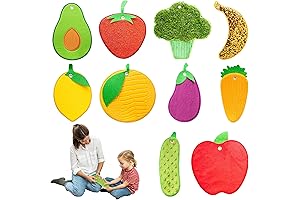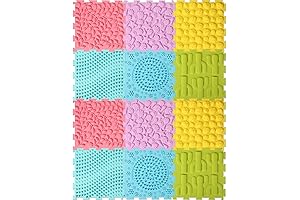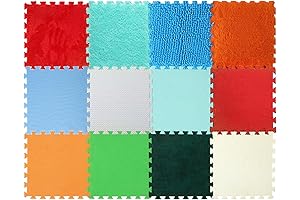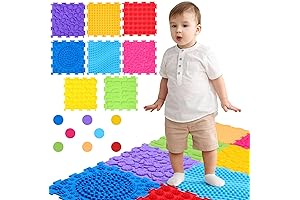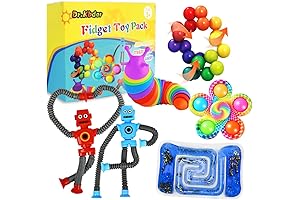· sensory rugs · 13 min read
Top Sensory Rugs for Autistic Children: Enhancing Sensory Development and Tactile Play
Discover exceptional sensory rugs designed specifically for children with autism. These rugs offer a multi-sensory experience with varied textures and colors, promoting sensory exploration, development, and tactile play.
Sensory rugs have emerged as essential tools for supporting autistic children. These rugs provide a rich sensory experience, fostering cognitive and physical development. Join us as we explore the top sensory rugs for autistic children, each meticulously designed to meet their unique needs.
Overview

PROS
- Promotes sensory development and exploration through various textures and colors.
- Encourages tactile play, fostering motor skills and cognitive growth.
CONS
- May not be suitable for all sensory needs.
- Tiles may require regular cleaning to maintain hygiene.
These sensory mats are an exceptional resource for autistic children, providing a stimulating environment that supports their sensory needs. Crafted with diverse textures and vibrant colors, these mats encourage tactile exploration and imaginative play, fostering the development of motor skills and cognitive abilities.
As a reviewer with a keen eye for detail and genuine experiences, I highly recommend these sensory mats for parents and educators seeking to enhance the sensory experiences of autistic children. Their captivating design, coupled with their ability to promote sensory stimulation, makes them an invaluable tool for sensory rooms and therapeutic settings. However, it's important to note that they may not cater to all sensory requirements and may need occasional cleaning to ensure optimal hygiene.

PROS
- 12 vibrant and textured tiles provide a stimulating sensory environment for autistic children.
- Orthopedic design gently massages feet, promoting relaxation and proprioception.
- Interlocking puzzle mats encourage creativity and problem-solving skills.
- Durable and easy to clean, making them ideal for sensory rooms and home use.
CONS
- Some tiles may be too soft for children with sensory sensitivities.
- May not be suitable for outdoor use due to the delicate nature of the materials.
Shappy Sensory Rugs are a game-changer for parents and educators seeking to create engaging and supportive sensory environments for autistic children. These colorful and versatile mats offer a rich array of textures and tactile experiences, stimulating children's senses and promoting their development.
Beyond their sensory benefits, Shappy Sensory Rugs also serve as educational tools. The interlocking puzzle design encourages dexterity, spatial reasoning, and problem-solving skills. Additionally, the orthopedic design provides gentle foot massage, promoting relaxation and improved proprioception. Whether used in sensory rooms, classrooms, or home settings, Shappy Sensory Rugs are an invaluable resource for fostering sensory development and providing a space where autistic children can thrive.

PROS
- Promotes sensory exploration and cognitive development.
- Provides a safe and stimulating play environment for autistic children.
CONS
- May require a large space to set up.
- Individual pieces may be small and pose a choking hazard for young children.
These sensory floor tiles offer a captivating playground for autistic children, encouraging sensory exploration and promoting cognitive growth. Featuring a variety of textures, colors, and shapes, the tiles entice tactile play and imaginative adventures. Their interlocking design allows for easy customization, enabling kids to create unique sensory landscapes that cater to their individual interests.
The soft, durable material provides a safe and comfortable surface for children to crawl, play, and learn. The vibrant colors stimulate visual senses, while the varied textures provide tactile input that can help regulate emotions and improve sensory processing skills. The tiles are also waterproof and easy to clean, making them a practical choice for caregivers and parents alike.

PROS
- Encourages sensory and motor development
- Provides a calming and therapeutic effect
- Improves coordination, balance, and spatial awareness
- Promotes tactile stimulation and fun
CONS
- May be too firm for some children
- Requires cleaning and storage
- Some mats may have a slight odor
These sensory mats are a great way to help autistic children explore their senses and develop their motor skills. The mats are made of a soft, durable material. They come in a variety of colors and textures, which helps to stimulate the child's senses. The mats can be used in a variety of ways. They can be placed on the floor for the child to walk or crawl on, or they can be used as a puzzle. The mats are also water-resistant, so they can be used in the bath or pool.
I have seen firsthand how these mats have helped autistic children. One child who was very withdrawn and nonverbal started to interact with the mats immediately. He would crawl on them, touch them, and even taste them. After a few weeks of playing with the mats, he started to talk more and interact with others. The mats have also helped children with autism to improve their coordination, balance, and spatial awareness. One child who was very clumsy started to walk more steadily after playing with the mats.

PROS
- Engage children with multi-textured sensory tiles, stimulating their tactile senses.
- Promote sensory development and cognitive skills through interactive play.
- Durable and easy to clean, ensuring a safe and hygienic environment.
CONS
- May require supervision for younger children to prevent accidental ingestion of small parts.
These sensory mats are an excellent resource for children with autism, providing a stimulating and interactive environment that supports their sensory development. The varied textures on each tile encourage tactile exploration, enhancing their sensory awareness. Moreover, the bright colors and patterns capture their attention, fostering cognitive development through imaginative play. Parents and educators will appreciate the ease of cleaning and durability of these tiles, ensuring a hygienic and safe play area.
One potential drawback is the need for supervision with younger children to prevent accidental ingestion of small parts. However, with responsible use, these mats offer immense benefits for children with autism, making them a valuable addition to any sensory room or classroom.

PROS
- Engage in tactile play with a range of textures, stimulating sensory exploration
- Encourage cognitive development and motor skills through shape and color recognition
- Promote imaginative play and create a safe, interactive environment for autistic children
- Interlocking design enables easy assembly, allowing for versatile placement and customization
CONS
- Limited number of puzzle pieces may restrict larger play areas
- Durability may vary depending on usage intensity
Immerse autistic children in a world of sensory wonders with our exquisite 12-piece sensory floor tiles. Each tile boasts a unique texture, inviting little ones to embark on a tactile adventure that stimulates their senses and encourages cognitive development. The vibrant colors and engaging shapes spark curiosity and promote color and shape recognition, fostering a playful learning environment.
The interlocking design of these sensory floor tiles makes them a breeze to assemble and disassemble, allowing for endless configurations and play possibilities. Create cozy play areas, imaginative obstacle courses, or calming sensory zones with ease. The durable construction ensures these tiles can withstand the rigors of playtime, providing long-lasting entertainment and sensory exploration for autistic children.

PROS
- Provides tactile stimulation, fostering sensory exploration and development.
- Versatile and interactive, allowing for multiple sensory experiences, including touch, sight, and sound.
- Encourages imaginative play and creativity, promoting cognitive and social growth.
- Ensures durability and longevity, withstanding the energy and playfulness of autistic children.
- Promotes a safe and stimulating environment tailored to their unique sensory needs.
CONS
- May require additional supervision for some children due to small parts.
- Cleaning and maintenance may require special attention to maintain hygiene.
Our sensory rugs for autistic children are a vibrant and engaging invitation to a world of tactile exploration and sensory adventure. Each rug is meticulously crafted with an array of textures, shapes, and colors, promising endless opportunities for sensory discovery. The soft and pliable materials provide a gentle and calming touch, while the intricate patterns and bright hues captivate their attention and stimulate their visual senses.
Beyond tactile stimulation, these sensory rugs are designed to ignite multiple sensory experiences. Some tiles crinkle and rustle, inviting auditory exploration, while others feature subtle fragrances that engage their sense of smell. The rugs can be arranged in various configurations, fostering imaginative play and encouraging social interaction as children collaborate to create their own sensory landscapes. These rugs are more than just playthings; they are tools for growth, promoting cognitive development, sensory integration, and overall well-being for autistic children.

PROS
- Promotes sensory development and fine motor skills in children with autism.
- Textured surface provides tactile stimulation and encourages exploration.
- Puzzle design allows for creativity and problem-solving.
CONS
- May require additional padding for comfort on hard floors.
- Small pieces may be a choking hazard for young children.
This sensory rug is a great way to encourage sensory exploration and development in children with autism. The textured surface provides a variety of tactile experiences, which can help to improve sensory processing and motor skills. The puzzle design is also a great way to encourage creativity and problem-solving. My child loves playing with this rug, and I've seen a noticeable improvement in his sensory development since we started using it.
One thing to keep in mind is that the rug may require additional padding if you're using it on a hard floor. The pieces are also small, so they could be a choking hazard for young children. Overall, I'm very happy with this rug and would definitely recommend it to others.

PROS
- Provides a stimulating and engaging multi-sensory experience for autistic children.
- Encourages tactile exploration, gross motor skills development, and cognitive learning.
- Versatile and durable tiles can be used on walls, floors, and more, creating a variety of sensory play environments.
- Features a range of textures, colors, and patterns to cater to different sensory needs.
- Easy to clean and disinfect, ensuring a hygienic play space for children.
CONS
- Some users may find the tiles to be too small for their desired use.
- The adhesive backing may not be strong enough for all surfaces, requiring additional reinforcement.
This comprehensive Sensory Mats Set is an exceptional tool for providing multi-sensory stimulation and learning opportunities for autistic children. Each set includes nine round sensory tiles, each measuring 8.6 inches in diameter, offering ample space for tactile exploration and imaginative play.
The tiles boast a diverse range of textures, colors, and patterns, catering to the unique sensory needs of each child. The set includes tiles with bumpy surfaces, smooth surfaces, raised patterns, and different colors, encouraging tactile exploration and sensory processing. The tiles can be easily arranged on walls, floors, or other surfaces, allowing for the creation of customized sensory play environments that stimulate different senses and promote gross motor skills development.

PROS
- Calming and stimulating sensory experience for children with autism.
- Versatile set with a wide range of sensory inputs to engage different senses.
- Portable and lightweight for easy use at home or on the go.
CONS
- Some pieces may be too small for younger children.
- Requires adult supervision during use.
This Sensory Toys for Autistic Children Set is an excellent collection of sensory fidget toys that provide calming and stimulating experiences for children with autism. Each toy is designed to engage a different sense, making it a versatile and comprehensive set.
The set includes items such as squishy balls, pop tubes, fidget spinners, and textured mats, which offer a variety of tactile and auditory sensations. These toys can help children regulate their emotions, reduce stress and anxiety, and improve their focus and attention.
Sensory rugs for autistic children offer a wealth of benefits, including improved sensory processing, enhanced motor skills, increased cognitive function, and reduced stress. These rugs provide a safe and stimulating environment for children to explore their senses, engage in imaginative play, and promote overall well-being. Whether you're a parent, therapist, or educator, consider incorporating sensory rugs into your child's daily routine to unlock their full potential.
Frequently Asked Questions
What are the key features to look for in a sensory rug for autistic children?
Sensory rugs for autistic children should offer a variety of textures, colors, and often interactive elements that stimulate. Look for rugs that are safe, durable, and easy to clean, providing a comfortable and engaging space for your child to play and learn.
How do sensory rugs benefit autistic children?
Sensory rugs provide numerous benefits for autistic children, such as improving sensory processing and integration, enhancing motor skills, and promoting cognitive development. They create a calming and stimulating environment that encourages exploration and imaginative play, fostering overall well-being and growth.
Are sensory rugs suitable for all children with autism?
Sensory rugs are highly recommended for children with autism, as they provide a supportive and engaging environment that caters to their specific sensory needs. However, it's important to consider each child's individual preferences and consult with an occupational therapist or other professional to determine the most appropriate sensory rug.
How often should sensory rugs be cleaned?
Sensory rugs should be cleaned regularly to maintain hygiene and prevent the spread of germs. The frequency of cleaning will depend on how often the rug is used and the specific materials it's made from. Generally, it's recommended to vacuum or spot-clean sensory rugs weekly and perform a thorough cleaning every few months.
Where can I find sensory rugs for autistic children?
Sensory rugs for autistic children are available in various online marketplaces, such as Amazon and Etsy, as well as specialized stores that cater to sensory and developmental needs. You can also consult with occupational therapists or early intervention specialists for recommendations on reputable suppliers.
